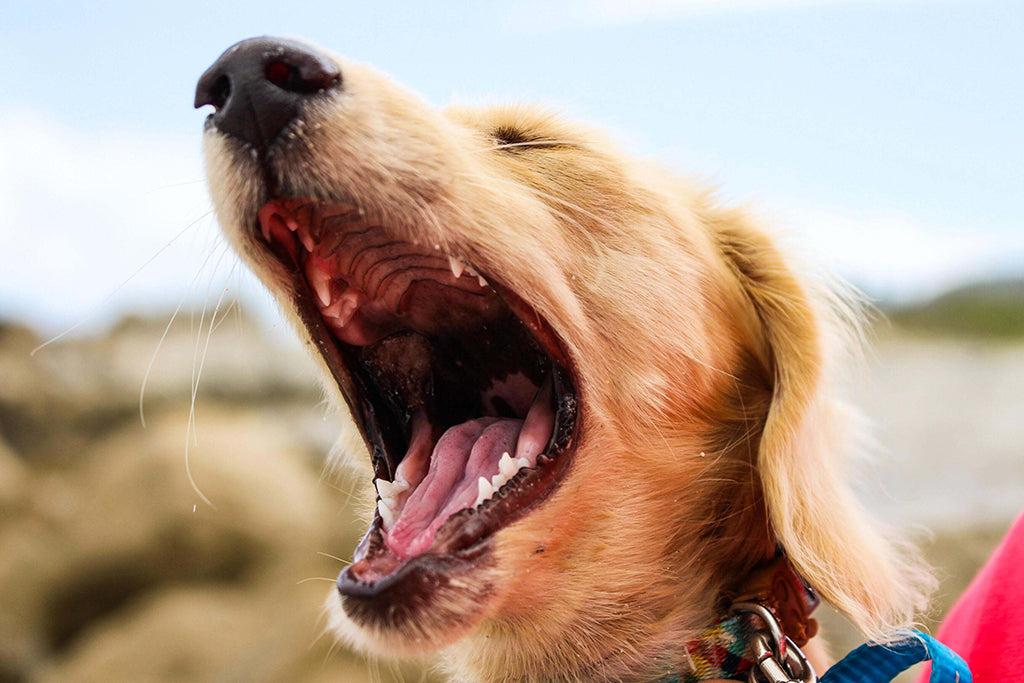Learn all about the dog mouth anatomy. We’ll discover what healthy dog gums should look like, brush up on dog teeth anatomy, and learn how to keep your dog’s mouth clean.
- Home/
- Dog/
- Health & Wellness/
- Everything You Need To Know About A Dog’s Mouth
Everything You Need To Know About A Dog’s Mouth

A dog’s mouth is an essential tool for how our canine companions experience the world. They use their mouths to lick, chew, eat, and breathe. Additionally, your dog uses their mouth to communicate with humans and other dogs through barks, whines, and growls.
Keeping your dog’s mouth clean and healthy is an important part of pet parenthood. But in order to care for your pet’s mouth, it’s helpful to have information about dog mouth anatomy, its functions, and common canine mouth problems. Let’s take a closer look.
Dog Mouth Anatomy
Like our human mouths, the dog mouth contains a tongue, teeth, and gums, and it is surrounded by cheeks and lips. It’s located in the front, lower part of the face. Their entire mouth is lined with mucus membranes that manufacture and secrete saliva from their glands, keeping the mouth moist and helping move debris and food down into the throat and digestive tract.
A dog’s mouth also acts as an airway, in addition to the nose. The mouth will be used more than the nasal passage to breathe when a dog exercises, becomes excited, or if the nose is blocked.
Dog Tongue
A dog’s tongue, like a human’s, primarily helps guide and process food and water into the esophagus. It has taste buds that allow your dog to process tastes and scents. The tongue also helps dogs regulate their body temperature when they pant. In addition, dogs use their tongues to clean themselves.
Dog Teeth
A dog’s teeth are used to chew, tear, nibble, carry, puncture and grind food and toys. They are used when playing with other pups or sometimes utilized to protect themselves from harm or attack.
Dog Gums
The gums in a dog’s mouth hold their teeth in place. The color of a dog’s gums can be a signal of their overall health. A dog’s gums should be bright pink in color and feel moist.
Dog Lips
Dogs do, in fact, have lips. They are sometimes called flews. However, a dog’s lips look and act differently than a human’s lips. The appearance of a dog’s lips varies based on breed. If dogs pull their lips back, it may even look like they are smiling.
Some dogs have lip folds and ridges called ruga. These ridges serve important functions, like gripping objects and protecting the lips from a dog’s sharp teeth during eating or playing. It’s important to keep these folds clean and dry because they are a common area for lip fold dermatitis to develop.
Dog Saliva
Dog saliva keeps the mouth moist and helps move food along in the mouth and into the digestive tract. Saliva also contains enzymes that help to break food down during dog digestion. A dog’s saliva does have antimicrobial compounds and histatins (antimicrobial proteins) that may protect against infections, but that doesn’t mean a dog’s wounds will heal if they lick them. In fact, licking a wound may cause more irritation and discomfort.

What Should a Dog’s Gums Look Like?
The color of a dog’s gums can often be a good indicator of where they’re at health-wise. Depending on your dog and their breed, a healthy set of dog gums should be pink. This pink can range from soft pink to bright pink. A set of healthy dog gums should also be moist.
If you press down on the pink gum, it should turn white. When your finger leaves the gum, it should then pop back to pink pretty much immediately, indicating good blood circulation. If your dog’s gums are pale or you press and the white color does not disappear quickly, you should see a veterinarian as soon as possible – as it can signal a serious health condition like anemia.
Some dogs have pigmentation on their gums, causing them to appear black or spotted in color. This is often a normal breed or genetic characteristic, but if you have any concerns about the color or appearance of your dog’s gums, you should contact your veterinarian.
How Many Teeth Do Dogs Have?
Adult dogs usually have 42 adult teeth – 20 on top and 22 on the bottom. In comparison, humans only have 32 teeth. So, dogs have more teeth than humans.
Puppies, on the other hand, only have 28 teeth. These deciduous teeth are very sharp and fall out as a puppy grows older. Puppy teeth generally begin falling out around 3-4 months and most dogs will have all of their adult teeth between 6 months and one year of age.
Dog Teeth Anatomy
The dog teeth anatomy includes:
Molars: Located at the far back of both the upper and lower jaw, these teeth crush and grind.
Premolars: The teeth just before the molars in both jaws, premolars tear and chew. You’ll know your dog is using their premolars when they tilt their head to one side to chew!
Canines: The long teeth that frame the smaller front teeth, a dog’s canines are used for puncturing and for holding objects in the mouth.
Incisors: The teeth right at the front of both jaws, incisors are utilized when nibbling, grooming or stripping meat.
For most doggies, when the jaws close the upper jaw’s incisors just overlap the lower ones. However, with most flat-faced breeds (like Boston Terriers, Bulldogs, or Pugs), the opposite occurs (an underbite) which can cause issues with eating and make these breeds more prone to tooth decay and gum disease.

Is A Dog’s Mouth Cleaner Than A Human’s?
It’s a common misconception that a dog’s mouth is cleaner than a human’s mouth. Both have a very similar amount of bacteria living in their mouths and both are full of different microbes — some that appear in both a dog’s and human’s mouth and some that don’t.
However, dog mouths and human mouths require manual cleaning because both are susceptible to gum discomfort and tooth plaque build-up.
7 Possible Dog Mouth Problems
A dog’s mouth needs regular attention and care to ensure that your canine companion is staying healthy. There are a variety of oral issues that may develop that require veterinary treatment. Pet parents should watch for the following dog mouth problems:
Gingivitis
Gingivitis is inflammation of your dog’s gums due to the buildup of bacteria, dirt, and food particles along the gumline. This can make a dog’s gums sensitive and inflamed – they may even bleed and become infected. Gingivitis may also cause bad breath in dogs. If pet parents don’t address gingivitis with at-home toothbrushing and professional cleanings, it could lead to more serious periodontal disease.
Dental Issues
A dog’s teeth play an important role in their health and wellbeing. But the buildup of tartar and plaque can lead to rotten teeth and severe periodontal disease. If left untreated, this can cause discomfort and trouble eating, and dogs may even need to have teeth removed.
Other possible dog dental issues include broken or chipped teeth, which can happen if a dog chews on something very hard like an antler or bone.
Dog Mouth Sores (Ulcers)
Dog mouth sores, or oral ulcers, are lesions in or outside of a dog’s mouth. They can vary by size and depth and be caused by a variety of issues ranging from infections to trauma caused by foreign bodies. Dog mouth ulcers may also be present along the gumline and due to periodontal disease.
Oral Tumors
Tumors in a dog’s mouth can be cancerous or benign (non-cancerous), so it’s important to get any bump or growth checked and evaluated by a veterinarian. Signs of dog mouth cancer may resemble other dog dental problems, so it’s important to receive a professional diagnosis.
Epulis in a dog’s mouth is one of the most common types of non-cancerous oral tumors that affect our canine companions. An epulis is a tumor that grows out of a dog’s gum tissue. Treatment involves surgically removing the tumor.
Lip Fold Dermatitis
Certain dog breeds – like Pugs, French Bulldogs, and Shar Peis — have more wrinkles and folds around their mouths. These folds may trap moisture and food debris leading to skin fold or lip fold dermatitis. Signs typically include redness, inflammation, skin bumps, and a bad odor.
Bleeding From the Mouth
A dog’s mouth may bleed for a variety of reasons. These can include periodontal disease, oral tumors, or trauma caused by cuts or foreign bodies. If you notice blood in your dog’s saliva, coming from your dog’s mouth, or on your dog’s chew toy, you should contact your veterinarian to determine the cause.
Bad Breath
Bad breath in dogs, called halitosis, can result from something your dog eats, but it may also happen due to dental problems or even illness. If your dog’s mouth smells bad suddenly or the bad breath lasts for an extended period, it’s time to call your veterinarian.
Keeping Your Dog’s Mouth Healthy
Regular brushing of your dog’s teeth and gums is essential for keeping your dog’s mouth as clean as it can be.
You can clean your dog’s teeth at home to target tartar buildup. Getting your dog used to mouth handling and toothbrushing will help you regularly inspect your dog’s mouth for potential issues.
Consider yearly professional dental cleanings by your veterinarian or a veterinary dentist. This is the most effective way to remove plaque and tartar from your dog’s teeth and prevent the onset of periodontal disease.
Be careful with the types of things you allow your dog to chew on. Very hard objects or items that can splinter can chip teeth or cause trauma in your dog’s mouth.
How To Clean A Dog’s Teeth
The key to avoiding occasional teeth and gum issues in your dog’s mouth is regular care. Dogs get plaque build-up just like we do, so they need to have their teeth brushed, too. To help your dog live a happy and full life, cleaning their teeth regularly is imperative.
You should brush your dog’s teeth at least 2-3 times a week with a dog toothpaste. Do not use human toothpaste on dogs, as it may contain ingredients that are harmful and toxic to dogs (such as artificial sweeteners or foaming agents).

PetLab Co. Pro Tip: It’s important to take your dog to the vet for a deep teeth cleaning at least once a year, preferably twice. These visits also give your vet a chance to do a thorough check, enabling them to spot and respond to any issues before they become big (and expensive!) problems.
Sources
“The Dog Dentition And The Purpose Of Each Teeth” Pedigree https://uk.pedigree.com/caring/my-dogs-health/the-dog-dentition-and-the-purpose-of-each-teeth
Author Dr. Spielman, Bari “Structure And Function Of The Tongue, Teeth And Mouth In Dogs” Aug 03. 2015, Pet Place https://www.petplace.com/article/dogs/pet-health/structure-and-function-of-the-tongue-teeth-and-mouth-in-dogs/
 S
S




